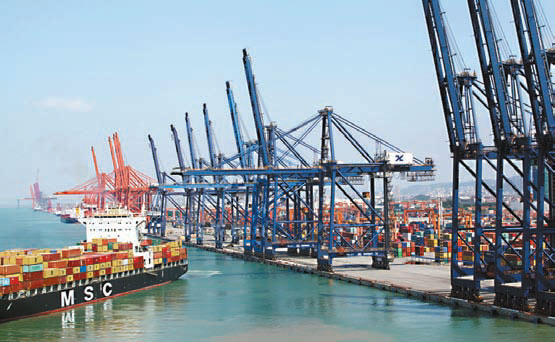Investing in the future
Updated: 2012-09-13 14:47
By Hu Meidong and Xiao Wang (China Daily)
|
||||||||
Xiamen's Haicang district is pushing for big changes for a prosperous tomorrow. Hu Meidong and Xiao Wang report.
 |
| Haicang aims to become an international shipping hub. [LIN GUANGMING / FOR CHINA DAILY] |
Haicang district in Xiamen, Fujian province - celebrated as the country's oldest and largest national-level Taiwan business investment zone - is embracing greater development opportunities at the 16th China International Fair for Investment and Trade in the city from Sept 8-11.
The district's two booths at the fair in the International Conference Exhibition Center will present a panoramic introduction of local development through pictures, text and videos.
About 200 people from 20 Fortune 500 enterprises and other key business delegates from home and abroad will join Haicang-related events at the fair. An additional 120 people will participate in the district's investment meeting.
The fair will also stage such cultural events as a singing competition and concerts.
Haicang covers 186 sq km and has a population of 282,000. Its industrial output and financial revenue respectively reached 76 billion yuan ($12 billion) and 4.16 billion yuan in 2010, and the local per capita GDP was $16,000.
The district's four pillar industries are machinery, digital information technology, port logistics and commercial tourism. The pharmaceutical, petrochemical, culture, new material and new energy sectors have also boomed in recent years.
The district's investment promotion bureau estimates that nearly 100 investment project contracts in Haicang will be signed at the fair, representing a 20 percent total investment volume increase compared to last year. There are 15 projects, each with investments surpassing $30 million.
The district adopts a "three-dimensional" policy to attract investment. It not only encourages investment from large State-owned enterprises but also from major domestic private companies and powerful foreign companies. It mainly invites them to put money in its 10 major investment promotion areas.
During this year's fair, more than 10 major projects will start or finish the construction in Haicang. Total investment will surpass 28 billion yuan.
The projects include a pharmaceutical industrial zone, an oil repertory area and an international logistics center. These will contribute to the establishment of a leading international shipping hub to serve as the vanguard of a conglomerate economic zone in the delta, including Xiamen, Zhangzhou and Quanzhou in Fujian's southeast.
Taiwan enterprises contributed 40 percent of Haicang's industrial output value in 2011. Haicang's future development will maintain its Taiwan-oriented characteristics.
It will build a cross-Straits cultural tourism center and focus more on cultural industries and facilitate the promotion of industrial structure. A regular dialogue system was built in April 2011 to help solve problems experienced by Taiwan merchants living in the district. It has been widely welcomed.
A cross-Straits traditional Chinese medicine museum, which covers 62,000 sq m and costs 160 million yuan, will open in the district and will be the largest of its kind in China. The planned medicine-related museum cluster will be an important hub for medical communication between the mainland and Taiwan.
Two "ports" will also contribute to the sustainability of the district's distinctive features.
One is the biomedicine port co-founded by the district government and Xiamen's municipal science and technology bureau.
The pharmaceutical industry in Haicang has taken a quarter of Fujian's output value. Its output is expected to hit 20 billion yuan by 2015.
The construction of 11 workshops will create an industry cluster. Four big pharmaceutical companies, bringing an investment of 421 million yuan, have been first-comers.
The municipal government has several policies to give impetus to the development of this industrial park and plans to launch one to five medical projects a year.
The other port is the Dongfu "land port" - officially the Southeast International Logistics Center - which covers an area of 58 hectares and costs 7 billion yuan.
It will combine the railway and other transportation channels to create a platform to concentrate logistics in the economic integration of Xiamen, Zhangzhou and Quanzhou - the "golden triangle" of southeastern Fujian.
As the local industry rapidly develops, the district government has continued promoting the facilities relevant to livelihoods. Projects are being planned to benefit residents and attract more newcomers - for instance, the 21 million yuan reconstruction of the main business area, Xin'anzhong Road.
The government will spend 58 million yuan to construct Haicang Second Experimental Elementary School. A residential community of 1,076 apartments in nine buildings, covering 11,600 sq m, will be build in years to come.
Haicang is ready to welcome guests from all over the world with its image of a fast-growing, hospitable, eco-friendly and thriving new town.

 Relief reaches isolated village
Relief reaches isolated village
 Rainfall poses new threats to quake-hit region
Rainfall poses new threats to quake-hit region
 Funerals begin for Boston bombing victims
Funerals begin for Boston bombing victims
 Quake takeaway from China's Air Force
Quake takeaway from China's Air Force
 Obama celebrates young inventors at science fair
Obama celebrates young inventors at science fair
 Earth Day marked around the world
Earth Day marked around the world
 Volunteer team helping students find sense of normalcy
Volunteer team helping students find sense of normalcy
 Ethnic groups quick to join rescue efforts
Ethnic groups quick to join rescue efforts
Most Viewed
Editor's Picks

|

|

|

|

|

|
Today's Top News
Health new priority for quake zone
Xi meets US top military officer
Japan's boats driven out of Diaoyu
China mulls online shopping legislation
Bird flu death toll rises to 22
Putin appoints new ambassador to China
Japanese ships blocked from Diaoyu Islands
Inspired by Guan, more Chinese pick up golf
US Weekly

|

|






